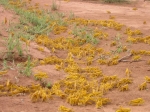Reproductive behavior of the solitarious desert locust, Schistocerca gregaria (Forskål), in relation to semiochemical attributes of desert plants
Abstract Category: Science
Course / Degree: Ph.D
Institution / University: University Of Khartoum, Sudan
Published in: 2004
Sexual attraction in the desert locust, Schistocerca gregaria (Forskål), was investigated by monitoring sexual behaviour of solitary-reared, gregarizing and gregarious locusts. Gregarizing males were significantly more attracted to volatiles from solitarious females than the solitarious males, depending on the length time they had been crowded. 24-day-crowded-solitarious males, traversed the longest distance toward the source of stimuli and also showed additional behavioural activities compared to the control, when no solitarious female was kept upwind. Besides, solitarious females despite grouped together did not gregarize and behaved similarly to solitary-reared ones. However, when solitarious females were grouped together from fledging for 24 days in a lower chamber of a bi-chamber cage with soltarious males (kept in the upper chamber) with olfactory and visual contact (but no tactile contact), they showed significantly more attraction to solitary-reared males.
Visual stimulus when provided in addition to olfactory stimulus, have been revealed important role in sexual attraction, as is involving both test and target insects in the sexual behaviour scenario and therefore, the number of test insects reaching the signal source increased significantly when compared to olfaction alone.
On the other hand, diel behavioural activity patterns of adult solitarious desert locust that were collected from the field in Port Sudan were investigated by monitoring walking/running, resting, taking off, and scanning in a wind tunnel. Solitarious locusts that had been propagated in the laboratory for 20 generations were also observed for comparison. In both groups of locusts, insects were significantly more active after sunset and this activity attained peak level at 1-2 hours after dusk. Of the two groups, solitarious locusts collected from the field were significantly more active. In the nocturnal phase, the former traversed distances that were about seven times those covered by laboratory-reared insects. Overall, the results showed that the repertoire of behavioural activities of solitarious locusts is maintained in laboratory-reared insects, albeit at a lower level. The implications of these observations in the behavioural ecology of the desert locust were discussed.
In the field, (Red sea coast) solitarious locusts feed on a range of desert plants (Heliotropium spp., Tribulus spp., Schouwia spp., …) whilst in the laboratory, locusts colonies were reared on wheat seedlings and wheat bran. The responsiveness of adult solitarious desert locust to odours from three host plants was evaluated in a two-choice wind tunnel. Solitarious desert locusts collected from the field (Red sea coast) were more attracted to volatiles from potted H. ovalifolium and Pennisetum. typhoides than to clean air, concurring with previous observations on ovipostion preferences near these plants. Furthermore, feeding choice among 2 annual and 1 perennial Heliotropium species growing in the same area showed that the annuals were more preferred than perennials; desert locusts balanced regularly their food intake between the 2 annual plants. This behaviour suggests that they may feed on more than one plant in the field.
Locusts reared for many generations on wheat seedlings (Triticum aesitivum) were more attracted to its volatiles than to clean air and volatiles from Heliotropium ovalifolium ones, a preferred host plant for feeding and oviposition in the field. Oviposition bioassays showed that, solitary-reared female locusts oviposited randomly in untreated sand and sand treated with lower doses of H. ovalifolium volatiles. However, at higher doses of the H. ovalifolium crude volatiles, locusts oviposited significantly more in the treated sand.
The reproductive status of solitarious females sampled at the end of the summer and onset of winter breeding seasons (at two locations in the coastal plains of Port Sudan that were 300 km apart and separated by a mountain range) was investigated. Results showed that all of the females collected at the onset of the winter season (100%) had laid eggs compared to a group of females caught at the end of the summer breeding season of which only 58% had laid eggs. Most of the oviposition was in December-January, which coincided with the appearance of the annual desert plants. Hence, the hatching of hoppers was at time when there were plenty of annual desert plants that ensured abundant food and shelter for the new generation. In addition, the time of oviposition, hatching of hoppers, adult emergence and subsequent synchronized maturation showed that within a winter breeding season (5-6 months) only one generation is likely to occur. Furthermore, females collected at the onset of the rainy season were more fecund and they were capable of laying egg pods throughout 5 successive months since their first mating at the beginning of the season.
Thesis Keywords/Search Tags:
activity patterns, behavior, desert locust, gregarious, host plant, mate location, oviposition, phase dynamics, pheromone, Schistocerca gregaria, solitarious, wind tunnel.
This Thesis Abstract may be cited as follows:
No user preference. Please use the standard reference methodology.
Submission Details: Thesis Abstract submitted by Sidi Ould Ely from Mauritania on 03-Apr-2011 00:22.
Abstract has been viewed 3882 times (since 7 Mar 2010).
Sidi Ould Ely Contact Details: Email: sidiouldely@yahoo.com Phone: +222 46 46 98 46
Disclaimer
Great care has been taken to ensure that this information is correct, however ThesisAbstracts.com cannot accept responsibility for the contents of this Thesis abstract titled "Reproductive behavior of the solitarious desert locust, Schistocerca gregaria (Forskål), in relation to semiochemical attributes of desert plants". This abstract has been submitted by Sidi Ould Ely on 03-Apr-2011 00:22. You may report a problem using the contact form.
© Copyright 2003 - 2025 of ThesisAbstracts.com and respective owners.
